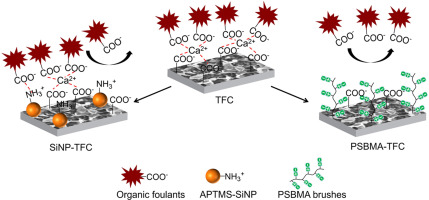当前位置:
X-MOL 学术
›
J. Membr. Sci.
›
论文详情
Our official English website, www.x-mol.net, welcomes your feedback! (Note: you will need to create a separate account there.)
Comparison of organic fouling resistance of thin-film composite membranes modified by hydrophilic silica nanoparticles and zwitterionic polymer brushes
Journal of Membrane Science ( IF 9.5 ) Pub Date : 2017-12-01 , DOI: 10.1016/j.memsci.2017.09.017 Caihong Liu , Jongho Lee , Chad Small , Jun Ma , Menachem Elimelech
Journal of Membrane Science ( IF 9.5 ) Pub Date : 2017-12-01 , DOI: 10.1016/j.memsci.2017.09.017 Caihong Liu , Jongho Lee , Chad Small , Jun Ma , Menachem Elimelech

|
We conducted a comparative study to investigate the efficacies of two different types of highly hydrophilic materials (i.e., silica nanoparticles (SiNPs) and zwitterionic polymers) for antifouling surface modification of polyamide thin-film composite (TFC) membranes. Dense layers of SiNPs and zwitterionic polymer brushes were grafted on the membrane surfaces via dip-coating with aminosilane-functionalized SiNPs (i.e., SiNP-TFC membrane) and surface-initiated atom-transfer radical-polymerization of sulfobetaine methacrylate (i.e., PSBMA-TFC membrane), respectively. With the same degree of enhancement of surface hydrophilicity and identical surface roughness, the PSBMA-TFC membrane exhibited significantly higher fouling resistance than the SiNP-TFC membrane in adsorption tests of proteins and bacteria as well as in forward osmosis (FO) dynamic fouling experiments using alginate as a model organic foulant. Chemical force microscopy measurements revealed that membrane-foulant electrostatic attraction aggravates organic fouling of the SiNP-TFC membrane to a certain degree, but the primary fouling mechanism is the complexation of organic foulants with carboxylic groups on the polyamide membrane surface. We attribute the lower fouling resistance of the SiNP-TFC membrane to the high density of surface carboxylic groups that may still be accessible to foulants as well as to membrane-foulant electrostatic interaction. On the contrary, the zwitterionic polymer brushes effectively shield the surface carboxylic groups and provide steric hindrance against foulant adsorption due to significant hydration of the zwitterionic brushes.
中文翻译:

亲水性二氧化硅纳米粒子与两性离子聚合物刷改性薄膜复合膜的有机污染性比较
我们进行了一项比较研究,以研究两种不同类型的高亲水性材料(即二氧化硅纳米粒子 (SiNP) 和两性离子聚合物)对聚酰胺薄膜复合材料 (TFC) 膜的防污表面改性的功效。通过浸涂氨基硅烷官能化的 SiNP(即 SiNP-TFC 膜)和表面引发的磺基甜菜碱甲基丙烯酸酯(即 PSBMA-TFC)的原子转移自由基聚合,将致密的 SiNP 层和两性离子聚合物刷接枝到膜表面。膜),分别。在相同程度的表面亲水性和相同的表面粗糙度下,在蛋白质和细菌的吸附测试以及使用藻酸盐作为模型有机污染物的正向渗透 (FO) 动态污染实验中,PSBMA-TFC 膜表现出明显高于 SiNP-TFC 膜的抗污染性。化学力显微镜测量表明,膜-污染物静电引力在一定程度上加剧了SiNP-TFC膜的有机污染,但主要的污染机制是有机污染物与聚酰胺膜表面的羧基络合。我们将 SiNP-TFC 膜的较低抗污染性归因于表面羧基的高密度,这些羧基仍然可能被污染物质以及膜-污染物质静电相互作用所影响。相反,
更新日期:2017-12-01
中文翻译:

亲水性二氧化硅纳米粒子与两性离子聚合物刷改性薄膜复合膜的有机污染性比较
我们进行了一项比较研究,以研究两种不同类型的高亲水性材料(即二氧化硅纳米粒子 (SiNP) 和两性离子聚合物)对聚酰胺薄膜复合材料 (TFC) 膜的防污表面改性的功效。通过浸涂氨基硅烷官能化的 SiNP(即 SiNP-TFC 膜)和表面引发的磺基甜菜碱甲基丙烯酸酯(即 PSBMA-TFC)的原子转移自由基聚合,将致密的 SiNP 层和两性离子聚合物刷接枝到膜表面。膜),分别。在相同程度的表面亲水性和相同的表面粗糙度下,在蛋白质和细菌的吸附测试以及使用藻酸盐作为模型有机污染物的正向渗透 (FO) 动态污染实验中,PSBMA-TFC 膜表现出明显高于 SiNP-TFC 膜的抗污染性。化学力显微镜测量表明,膜-污染物静电引力在一定程度上加剧了SiNP-TFC膜的有机污染,但主要的污染机制是有机污染物与聚酰胺膜表面的羧基络合。我们将 SiNP-TFC 膜的较低抗污染性归因于表面羧基的高密度,这些羧基仍然可能被污染物质以及膜-污染物质静电相互作用所影响。相反,



























 京公网安备 11010802027423号
京公网安备 11010802027423号